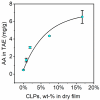Three-Dimensional Printed Cell Culture Model Based on Spherical Colloidal Lignin Particles and Cellulose Nanofibril-Alginate Hydrogel
- PMID: 31992046
- PMCID: PMC7218745
- DOI: 10.1021/acs.biomac.9b01745
Three-Dimensional Printed Cell Culture Model Based on Spherical Colloidal Lignin Particles and Cellulose Nanofibril-Alginate Hydrogel
Abstract
Three-dimensional (3D) printing has been an emerging technique to fabricate precise scaffolds for biomedical applications. Cellulose nanofibril (CNF) hydrogels have attracted considerable attention as a material for 3D printing because of their shear-thinning properties. Combining cellulose nanofibril hydrogels with alginate is an effective method to enable cross-linking of the printed scaffolds in the presence of Ca2+ ions. In this work, spherical colloidal lignin particles (CLPs, also known as spherical lignin nanoparticles) were used to prepare CNF-alginate-CLP nanocomposite scaffolds. High-resolution images obtained by atomic force microscopy (AFM) showed that CLPs were homogeneously mixed with the CNF hydrogel. CLPs brought antioxidant properties to the CNF-alginate-CLP scaffolds in a concentration-dependent manner and increased the viscosity of the hydrogels at a low shear rate, which correspondingly provide better shape fidelity and printing resolution to the scaffolds. Interestingly, the CLPs did not affect the viscosity at high shear rates, showing that the shear thinning behavior typical for CNF hydrogels was retained, enabling easy printing. The CNF-alginate-CLP scaffolds demonstrated shape stability after printing, cross-linking, and storage in Dulbecco's phosphate buffer solution (DPBS +) containing Ca2+ and Mg2+ ions, up to 7 days. The 3D-printed scaffolds showed relative rehydration ratio values above 80% after freeze-drying, demonstrating a high water-retaining capability. Cell viability tests using hepatocellular carcinoma cell line HepG2 showed no negative effect of CLPs on cell proliferation. Fluorescence microscopy indicated that HepG2 cells grew not only on the surfaces but also inside the porous scaffolds. Overall, our results demonstrate that nanocomposite CNF-alginate-CLP scaffolds have high potential in soft-tissue engineering and regenerative-medicine applications.
Conflict of interest statement
The authors declare no competing financial interest.
Figures









Similar articles
-
Biomimetic Mineralization of Three-Dimensional Printed Alginate/TEMPO-Oxidized Cellulose Nanofibril Scaffolds for Bone Tissue Engineering.Biomacromolecules. 2018 Nov 12;19(11):4442-4452. doi: 10.1021/acs.biomac.8b01325. Epub 2018 Oct 19. Biomacromolecules. 2018. PMID: 30301348
-
In situ mineralization of nano-hydroxyapatite on bifunctional cellulose nanofiber/polyvinyl alcohol/sodium alginate hydrogel using 3D printing.Int J Biol Macromol. 2020 Oct 1;160:538-547. doi: 10.1016/j.ijbiomac.2020.05.181. Epub 2020 May 26. Int J Biol Macromol. 2020. PMID: 32470581
-
Improvement of cell deposition by self-absorbent capability of freeze-dried 3D-bioprinted scaffolds derived from cellulose material-alginate hydrogels.Biomed Phys Eng Express. 2020 May 14;6(4):045009. doi: 10.1088/2057-1976/ab8fc6. Biomed Phys Eng Express. 2020. PMID: 33444270
-
Alginate based hydrogel inks for 3D bioprinting of engineered orthopedic tissues.Carbohydr Polym. 2022 Nov 15;296:119964. doi: 10.1016/j.carbpol.2022.119964. Epub 2022 Aug 5. Carbohydr Polym. 2022. PMID: 36088004 Review.
-
Nanocomposite bioinks for 3D bioprinting.Acta Biomater. 2022 Oct 1;151:45-69. doi: 10.1016/j.actbio.2022.08.014. Epub 2022 Aug 13. Acta Biomater. 2022. PMID: 35970479 Review.
Cited by
-
Light Processable Starch Hydrogels.Polymers (Basel). 2020 Jun 17;12(6):1359. doi: 10.3390/polym12061359. Polymers (Basel). 2020. PMID: 32560332 Free PMC article.
-
Gene-Expression Analysis of Human Fibroblasts Affected by 3D-Printed Carboxylated Nanocellulose Constructs.Bioengineering (Basel). 2023 Jan 16;10(1):121. doi: 10.3390/bioengineering10010121. Bioengineering (Basel). 2023. PMID: 36671693 Free PMC article.
-
Polysaccharide-based biomaterials in a journey from 3D to 4D printing.Bioeng Transl Med. 2023 Mar 22;8(4):e10503. doi: 10.1002/btm2.10503. eCollection 2023 Jul. Bioeng Transl Med. 2023. PMID: 37476065 Free PMC article. Review.
-
Three-dimensional printing of wood.Sci Adv. 2024 Mar 15;10(11):eadk3250. doi: 10.1126/sciadv.adk3250. Epub 2024 Mar 15. Sci Adv. 2024. PMID: 38489368 Free PMC article.
-
Synthesis of a Liquid Lignin-Based Methacrylate Resin and Its Application in 3D Printing without Any Reactive Diluents.Biomacromolecules. 2023 Apr 10;24(4):1751-1762. doi: 10.1021/acs.biomac.2c01505. Epub 2023 Mar 17. Biomacromolecules. 2023. PMID: 36926866 Free PMC article.
References
-
- Chun H. J.; Park K.; Kim C.-H.; Khang G.. Novel Biomaterials for Regenerative Medicine; Springer, Singapore: Singapore, 2018.
-
- De France K. J.; Badv M.; Dorogin J.; Siebers E.; Panchal V.; Babi M.; Moran-Mirabal J.; Lawlor M.; Cranston E. D.; Hoare T. Tissue Response and Biodistribution of Injectable Cellulose Nanocrystal Composite Hydrogels. ACS Biomater. Sci. Eng. 2019, 5 (5), 2235–2246. 10.1021/acsbiomaterials.9b00522. - DOI - PubMed
Publication types
MeSH terms
Substances
LinkOut - more resources
Full Text Sources
Other Literature Sources
Miscellaneous

